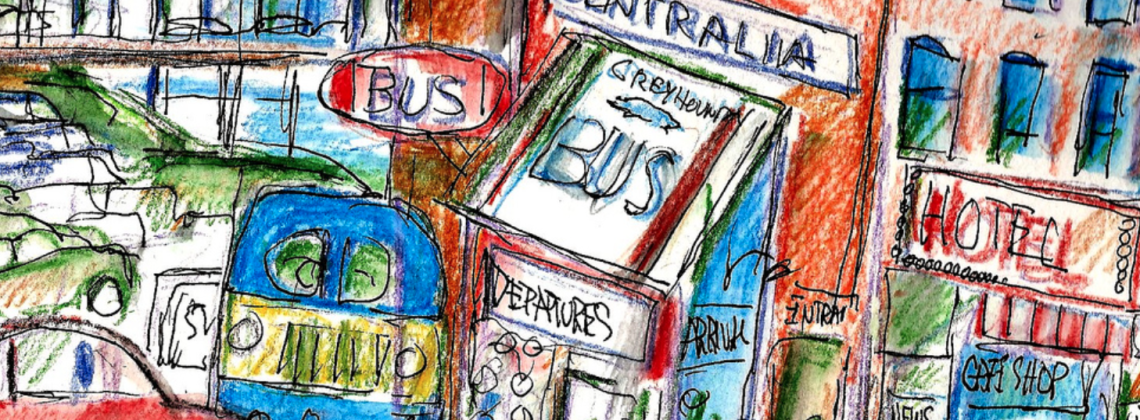

How far will you let comfort take you?
Inside the little library in my hometown is a little art gallery and the little art gallery is called The Little Art Gallery and, if anything tidier ever existed, I’m not aware of it. A little art gallery called The Little Art Gallery attached to a little library in a little town that typifies Americana suggests certain kinds of art that librarians—for, as a kid, I assumed they were the gatekeepers—might curate. Thomas Kinkade-y schlock comes to mind, with apologies to all librarians everywhere, but I’m happy to say the fare in The Little Art Gallery has always been good.
My family went to the library all the time and sometimes we’d stroll through The Little Art Gallery after we checked out our books. Once, on one of these family gallery walks, there was a shadow box hanging on one of the walls. Inside the box was a mask and the mouth hung wide-open. The artist had covered the mask with plain white sheets of plaster of Paris. The hardened sheets and their draping effect blunted the mask’s specificity. It was a contorted depiction of a terrorized nobody-in-particular. The piece was called The Holocaust.
I must’ve learned about the Holocaust in school. Where else? I can’t cite the class, the grade level, or teacher. Middle school, maybe? High school? Mr. Heigl? He taught history. Most things from those school days are a gummy blur. But the Holocaust-as-academic-subject-matter must’ve been evenly arrayed next to everything else. Covalent bonds, Mark Twain, dodgeball. It was a subject you talked about because, and only when, you had to. One or two questions on an exam at the end of the year, in other words. I understood the Holocaust in the same way I understood word problems. If I start with 9.5 million Jewish people in Europe and subtract 6 million, how many Jewish people remain?
My parents took my sister and me to see Schindler’s List in the theater when it came out. I knew about the movie from the waves it made, or at least from the fact that Steven Spielberg’s name was already in everybody’s mouths that year since Jurassic Park had been released six months prior. Schindler’s List was, perhaps, my parents’ only way to connect a modicum of tangibility to an appalling event that occurred a generation prior to theirs. The only option to move my sister and me out of a kid-‘n’-classroom kind of understanding of the Holocaust, and closer to an authentic understanding of the Holocaust’s barbarity.
But what an order. An “authentic understanding of the Holocaust’s barbarity” must be an impossibility. Infinitely approachable but never wholly ascertainable. Like a runway where an airplane could taxi forever but never take off. It’s the great, unjust inequality of the human condition: We possess the easy capacity to wreak calculated, hate-filled, mass-scale destruction, we lack the capacity to understand what we’ve done, and we are, therefore, in full possession of the ability to do it again.
Spielberg based his movie on Thomas Keneally’s 1982 book Schindler’s Ark and, while both the movie and the book painstakingly document Oskar Schindler, the Schindlerjuden, and the bureaucratized hatred that fueled the Nazis’ insane attempt to remake the world, neither definitively explains why Schindler saved all those people. He was an unlikely good guy. In addition to his own membership in the Nazi party, he was an opportunistic war profiteer, a constant philanderer, probably a drunk, and an irreligious Catholic. At the war’s outset he had more, much more, in common with his psychotic counterpoint, Amon Goeth—the Nazi Commandant of the Krakow-Plaszow concentration camp, from which Schindler rescued most of his workers—than any one of World War II’s more obvious heroes.
But, of course, neither Keneally nor Spielberg, in their respective works, claim to explain the massive “Why did he do it?” question. Schindler himself never answered it, never fully, and he died in poverty after the war. Who is left who knows the answer? God? But on the subject, we haven’t heard anything from on high. It may be that even God is unsure.
God is clever, though. It would be just like God to keep mum so the question as to why one would secretly intercede for an oppressed people—and, pointedly in Schindler’s case, an oppressed people whom his own people were oppressing—hangs like a living mirror on history’s wall. Each individual member of each successive generation must now see themselves in the living question. To explain is to categorize, to categorize is to depersonalize, to depersonalize is to comfort oneself, and a mass of comfortable people aren’t easily moved to act on behalf of anybody else for any reason. Comfort is gravity with blackhole strength, drawing any and all justifications to itself to prolong its own life. Congruency with any claimed core values be damned.
Why did Schindler do it? without an exact answer in his own time (and, perhaps, in his own mind) becomes Why would I do it? in my own time and mind. Why, if given the chance, labor to save lives at the risk of my own? Why mercy today? Why courage in the days to come? Why self-sacrifice? Why compassion? Why, self? Why?
Paul Luikart is the author of several short story collections , including his just-released The Realm of the Dog. He serves as an adjunct professor of fiction writing at Covenant College in Lookout Mountain, Georgia and lives in Chattanooga, Tennessee.